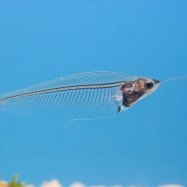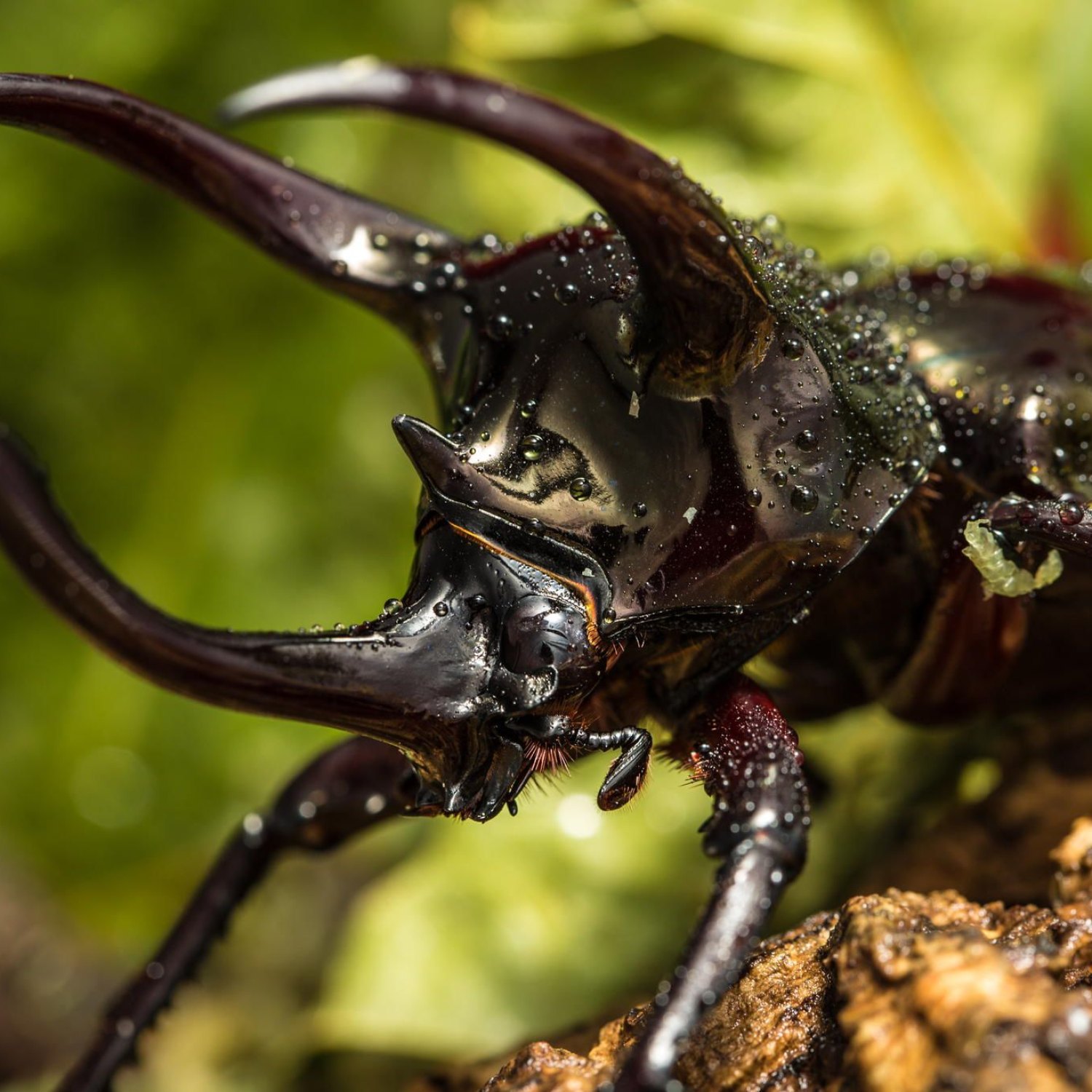
Atlas Beetle
5-10 centimeters (2-4 inches)
The Atlas Beetle is a fascinating insect found in the trees of the rainforest. Measuring 5-10cm in length, this oval and elongated creature belongs to the Scarabaeidae family. Its shiny and colorful appearance makes it a common sight in the forest, but be careful not to confuse it with other beetles as they can be harmful to trees. #AtlasBeetle #Rainforest #Insects
Animal Details Summary:
Common Name: Atlas Beetle
Kingdom: Animalia
Habitat: Tropical rainforests
The Remarkable Atlas Beetle: Jewel of the Rainforest
The Atlas Beetle, also known as the Chalcosoma Atlas, is a magnificent insect that has captured the fascination and wonder of humans for centuries. With its iridescent black color and impressive size, it is not surprising that this beetle is considered a prized possession by many insect collectors. But beyond its physical appearance, the Atlas Beetle has a rich history and unique characteristics that make it stand out from other insects.The Basics of the Atlas Beetle
The Atlas Beetle belongs to the kingdom Animalia, which includes all living creatures that are classified as animals Atlas Beetle. It is part of the phylum Arthropoda, meaning that it has a segmented body and exoskeleton made of chitin. Within the class Insecta, the Atlas Beetle is classified under the order Coleoptera, which is the largest order in the animal kingdom and comprises approximately 40% of all insect species.The Atlas Beetle is part of the Scarabaeidae family, which also includes other famous beetles such as the dung beetle and the rose chafer. This family is known for its diverse range of sizes, shapes, and behaviors. However, unlike its fellow family members, the Atlas Beetle stands out with its impressive size, making it a unique and sought-after species.
A Home in the Tropical Rainforest
The Atlas Beetle is native to Southeast Asia, particularly the country of Indonesia. Its natural habitat is the tropical rainforests, where it can be found high up in the trees. This beetle thrives in the warm and humid climate, perfectly adapted to its surroundings.The rainforest provides the perfect environment for the Atlas Beetle to complete its life cycle Akita. The larvae of this beetle live in decaying logs and feed on rotting wood, serving an important role in the ecosystem as detritivores. As adults, they spend most of their time in the treetops, feeding on fruits and tree sap.
The Beauty of the Atlas Beetle's Appearance
The Atlas Beetle is known for its strikingly beautiful appearance, with its glossy black exoskeleton. This iridescent color is partially due to the microstructure of its outer layer, which reflects light in a way that gives off a metallic sheen. Its body shape is oval and elongated, giving it a streamlined appearance, perfect for climbing trees.On the head of the Atlas Beetle, you will notice two large mandibles or jaws that are used for gripping onto branches and fruits. These mandibles are also used during mating, where the male will use them to protect the female during copulation.
A Large Insect Amongst Insects
One of the most fascinating features of the Atlas Beetle is its size. It is considered one of the largest beetles in the world, measuring at an impressive 5-10 centimeters in length (2-4 inches). To put this into perspective, the average housefly measures only 6-10 millimeters.The size of the Atlas Beetle is a significant advantage, as it helps them to intimidate predators and claim their territory high up in the trees. It also makes them a popular target for insect collectors who prize large and unique specimens.
The Lifecycle of the Atlas Beetle
The life cycle of the Atlas Beetle begins when the female lays her eggs in a decaying log. The larvae will hatch and feed on the rotting wood for several months, growing in size until they pupate.After pupation, the adult emerges and spends its time in the trees, feeding and mating. While the lifespan of the Atlas Beetle is not precisely known, it is estimated to be around 2-4 years.
The Impact of Humans on the Atlas Beetle's Population
Humans have had a significant impact on the population of the Atlas Beetle, particularly through deforestation. The destruction of the rainforest has led to the loss of the beetle's habitat and food sources, resulting in a decline in their population.Additionally, illegal collection for the exotic pet trade has also played a role in the decline of this species. Poachers capture and sell Atlas Beetles for high prices, often exploiting vulnerable populations in the wild.
Conservation Efforts for the Atlas Beetle
Fortunately, there have been conservation efforts to protect the Atlas Beetle and preserve its natural habitat. Organizations have been working towards educating locals and tourists about the importance of preserving the rainforest and its inhabitants, such as the Atlas Beetle.These efforts have also included creating protected areas and implementing sustainable practices for logging and agriculture. It is crucial to continue these conservation efforts to ensure the survival of the Atlas Beetle for generations to come.
In Conclusion
The Atlas Beetle is truly a remarkable creature, possessing both beauty and strength. From its striking appearance to its vital role in the rainforest ecosystem, it is a fascinating insect that deserves our admiration and protection.As we continue to explore and learn more about the natural world, let us not forget the importance of preserving and respecting the creatures that inhabit it. The Atlas Beetle is a reminder of the incredible diversity and wonder of the animal kingdom and the importance of conservation efforts to protect them.

Atlas Beetle
Animal Details Atlas Beetle - Scientific Name: Chalcosoma atlas
- Category: Animals A
- Scientific Name: Chalcosoma atlas
- Common Name: Atlas Beetle
- Kingdom: Animalia
- Phylum: Arthropoda
- Class: Insecta
- Order: Coleoptera
- Family: Scarabaeidae
- Habitat: Tropical rainforests
- Feeding Method: Detritivore
- Geographical Distribution: Southeast Asia
- Country of Origin: Indonesia
- Location: Trees of the rainforest
- Animal Coloration: Black
- Body Shape: Oval and elongated
- Length: 5-10 centimeters (2-4 inches)
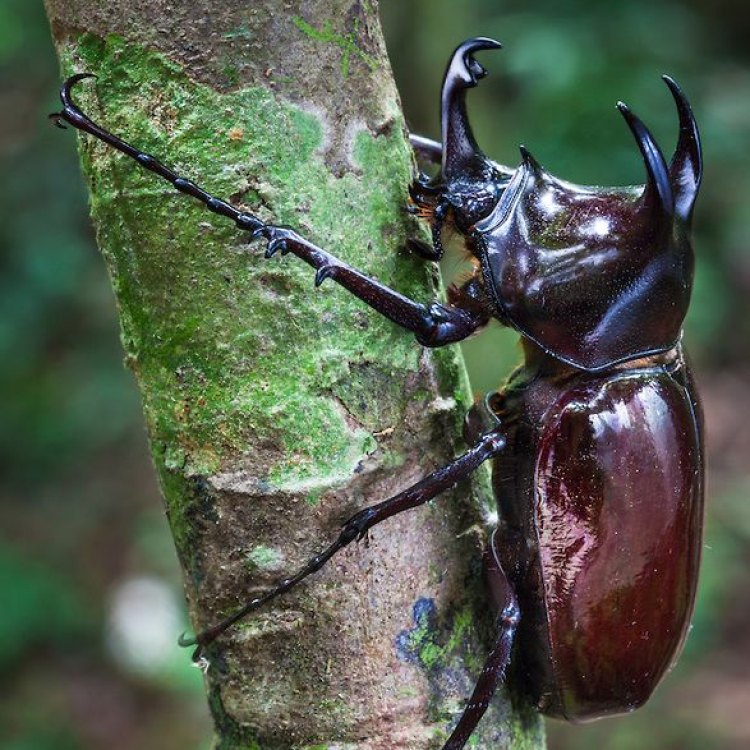
Atlas Beetle
- Adult Size: Large, one of the largest beetles in the world
- Average Lifespan: 6-12 months
- Reproduction: Sexual
- Reproductive Behavior: Males fight for mating rights with females
- Sound or Call: No specific sound or call
- Migration Pattern: Non-migratory
- Social Groups: Solitary
- Behavior: Nocturnal
- Threats: Habitat loss and illegal collecting
- Conservation Status: Not evaluated
- Impact on Ecosystem: Important decomposers
- Human Use: Popular in insect collections
- Distinctive Features: Large size and distinct horn-like projections on the males
- Interesting Facts: Males have enlarged mandibles that they use to fight each other.
- Predator: Birds, reptiles, and small mammals
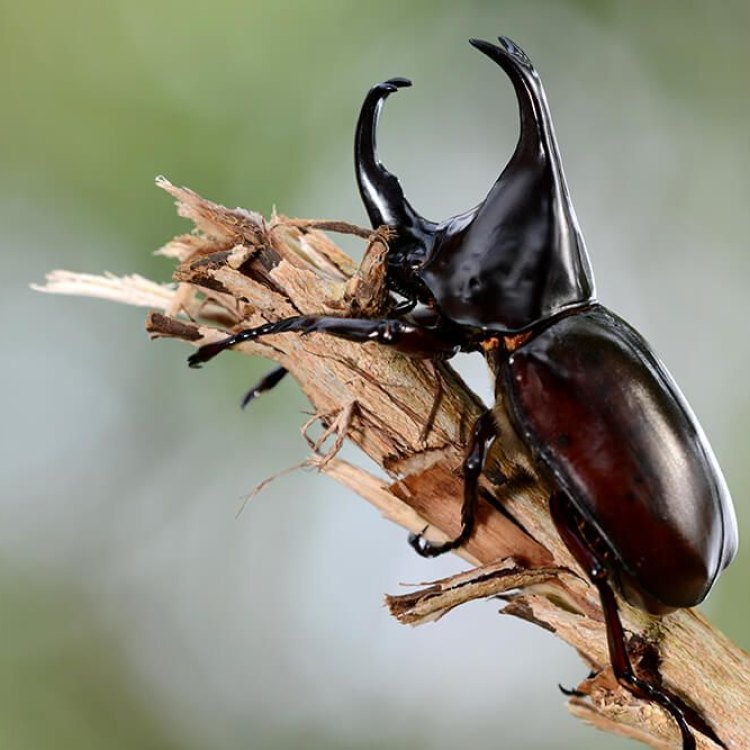
Chalcosoma atlas
The Mighty Atlas Beetle: Nature's Giant Decomposer
In the world of insects, there are countless fascinating species that never fail to capture our attention. From the delicate butterfly to the industrious ant, each insect has its own unique characteristics that make it a vital part of our ecosystem. However, there is one particular insect that stands out among the rest – the Atlas Beetle.The Atlas Beetle (Chalcosoma atlas) is a species of rhinoceros beetle that belongs to the family Scarabaeidae PeaceOfAnimals.Com. These beetles can be found in various parts of Asia, including Borneo, Malaysia, and Indonesia. They are also known by different names such as the elephant beetle, the coconut beetle, and the Hercules beetle – all of which are a testament to their incredible strength and size.
Adult Atlas beetles are considered to be one of the largest beetles in the world, with some individuals reaching up to 5 inches in length. Their impressive size, along with their striking appearance, has made them a popular choice for insect collectors. However, there is much more to these beetles than just their size and appearance.
In this article, we will delve into the unique features of the Atlas beetle, its behavior, and its impact on the ecosystem, shedding light on why this insect is truly a marvel of nature.
A Glimpse into the Life of an Atlas Beetle
The average lifespan of an Atlas beetle is 6 to 12 months, which is quite impressive for an insect of this size. Like most beetles, they go through a complete metamorphosis, starting from an egg, then a larva, pupa, and finally into an adult.The reproductive behavior of Atlas beetles is sexual and involves males battling for the right to mate with females Alpine Goat. The males use their distinctive horn-like projections to engage in fights, commonly known as "horn wrestling." These battles can be quite intense, with the stronger and more dominant male emerging as the winner and earning the chance to mate with the female.
It is worth noting that Atlas beetles do not make any specific sounds or calls, making them silent creatures. This is unlike many other insects that rely on sound to communicate, such as crickets or cicadas.
A Lone Ranger: Solitary Social Groups
Unlike some insects that live in large colonies or communities, Atlas beetles are solitary insects. This means that they prefer to live alone and do not form social groups. However, during the mating season, you may find multiple beetles in one place due to their reproductive behavior, but they quickly go back to their solitary lifestyle once mating is over.A Night Owl: Nocturnal Behavior
Another interesting feature of Atlas beetles is their nocturnal behavior. These beetles are most active at night, and they spend their days hiding under leaves and logs or burrowing in the soil. This is because they are sensitive to sunlight and prefer the darkness of the night for activities such as foraging for food and finding a mate.Threats to the Mighty Atlas Beetle
Like many other insects, the Atlas beetle faces numerous threats, including habitat loss and illegal collecting. This beetle predominantly lives in tropical forests, which are increasingly disappearing due to human activities such as deforestation and urbanization. In some regions, the illegal collection of Atlas beetles for sale in the exotic pet trade is also a major threat to their population.Unfortunately, it is challenging to determine the exact population status of Atlas beetles, as they have not been evaluated by the International Union for Conservation of Nature (IUCN). However, considering the threats they face, it is safe to say that their numbers are declining, and they may face the risk of extinction in the future.
The Crucial Role of Atlas Beetles in the Ecosystem
One of the most crucial roles that Atlas beetles play in the ecosystem is that of decomposers. These beetles feed on decaying organic matter, such as fallen trees and animal carcasses, breaking them down and returning valuable nutrients to the soil. This process is essential in maintaining a healthy and balanced ecosystem.From the Wild to Collectors' Collections: Human Use of Atlas Beetles
It is no secret that insects, including the Atlas beetle, are a popular addition to many insect collectors' collections. These beetles are prized for their impressive size and unique appearance, making them a sought-after species in the world of insect collecting.The popularity of Atlas beetles has led to a thriving trade in the exotic pet industry. However, it is crucial to note that collecting them from the wild can have a severe impact on their population and the delicate balance of the ecosystem they are a part of.
Distinctive Features: Big Size and Bigger Mandibles
While the large size of Atlas beetles is their most noticeable feature, there is one other feature that sets them apart from other beetles – their enlarged mandibles. These mandibles, which are found in the males, are used not only for fighting but also for defense and feeding. They are incredibly strong and can exert a force of up to 100 times their body weight, making them one of the strongest animals in the world in terms of bodyweight to strength ratio.Did You Know?
Apart from their impressive size and strength, there are several other interesting facts about Atlas beetles that are worth mentioning. For instance, these beetles can lift objects up to 850 times their own body weight, making them one of the strongest animals in the world relative to their size. Additionally, while most beetles have two sets of wings, Atlas beetles have just one functional pair, making them clumsy fliers.Predators of the Mighty Atlas Beetle
Like all other creatures, Atlas beetles also have their fair share of predators. They are commonly preyed upon by birds, reptiles, and small mammals. However, the hardened exoskeleton of the beetles acts as a protective shield, making it difficult for their predators to attack and consume them.The Verdict: A True Marvel of Nature
When we look at the Atlas beetle as a whole, it is clear that this insect is truly a marvel of nature. From its impressive size and strength to its important role in the ecosystem, there is no denying the incredible significance of this beetle.As we continue to learn more about insects and their importance in the natural world, it is crucial that we also work towards conserving and protecting them. Each species, no matter how small or big, plays a vital role in maintaining the balance of our planet's fragile ecosystem. And the mighty Atlas beetle is no exception.
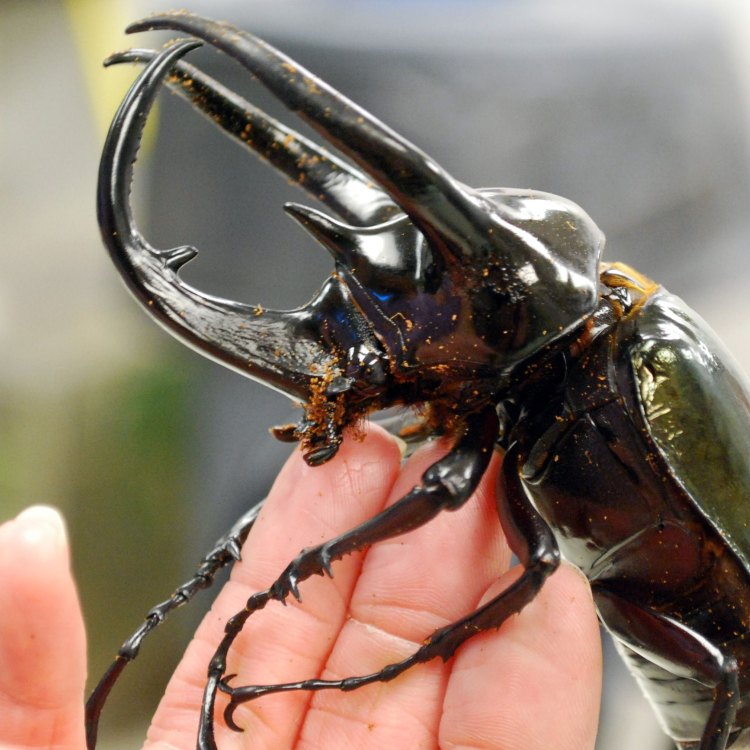
The Remarkable Atlas Beetle: Jewel of the Rainforest
Disclaimer: The content provided is for informational purposes only. We cannot guarantee the accuracy of the information on this page 100%. All information provided here may change without prior notice.






